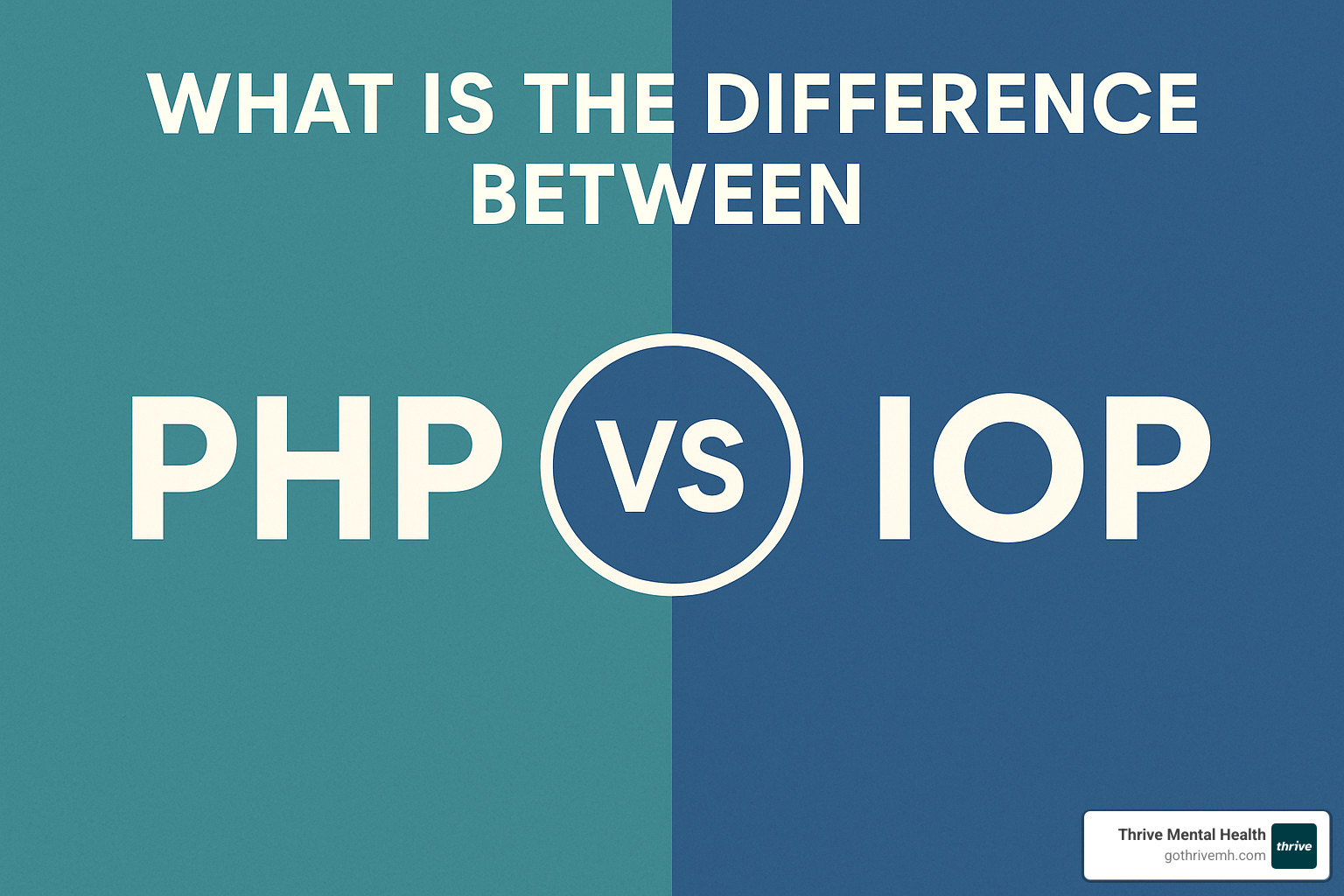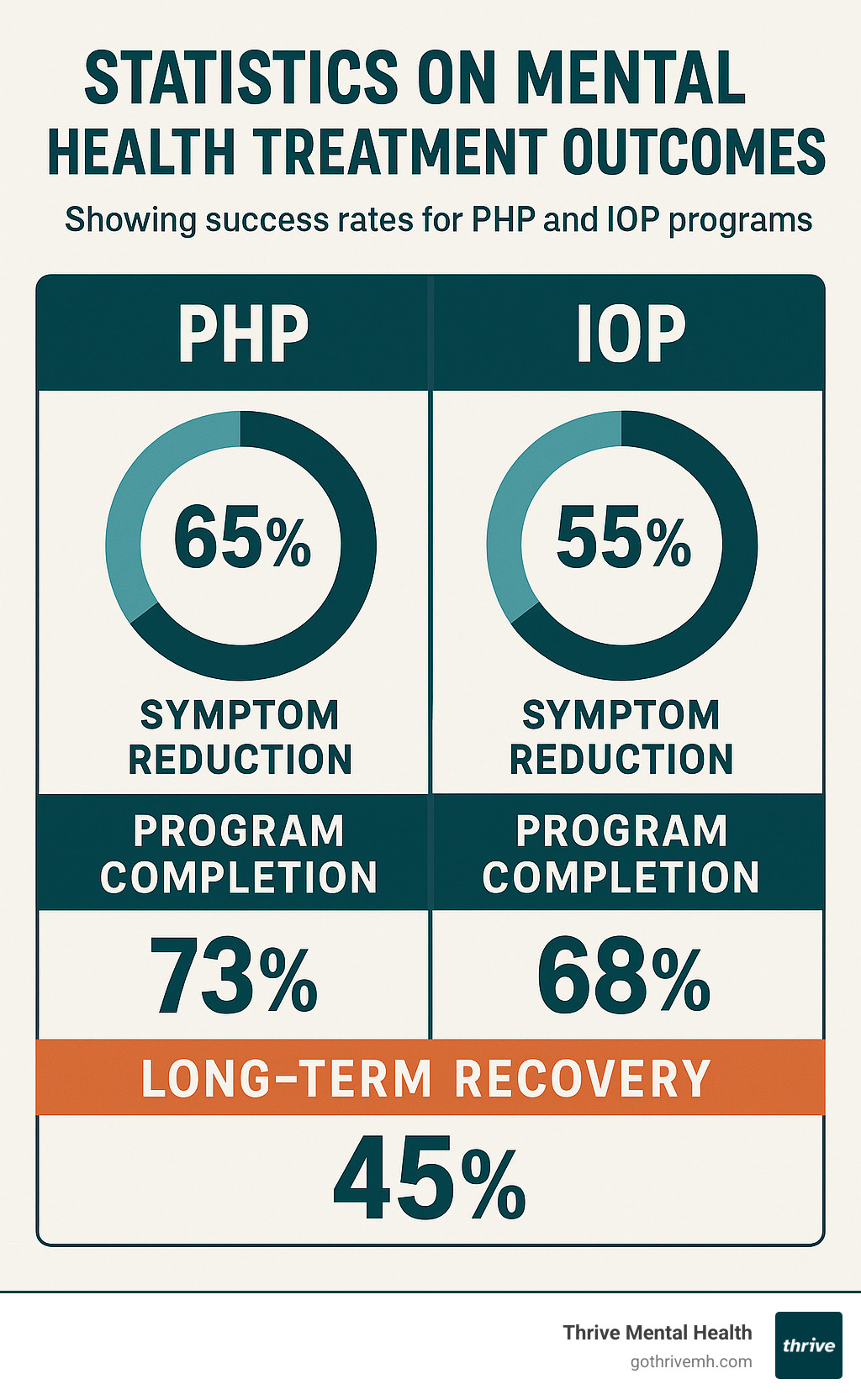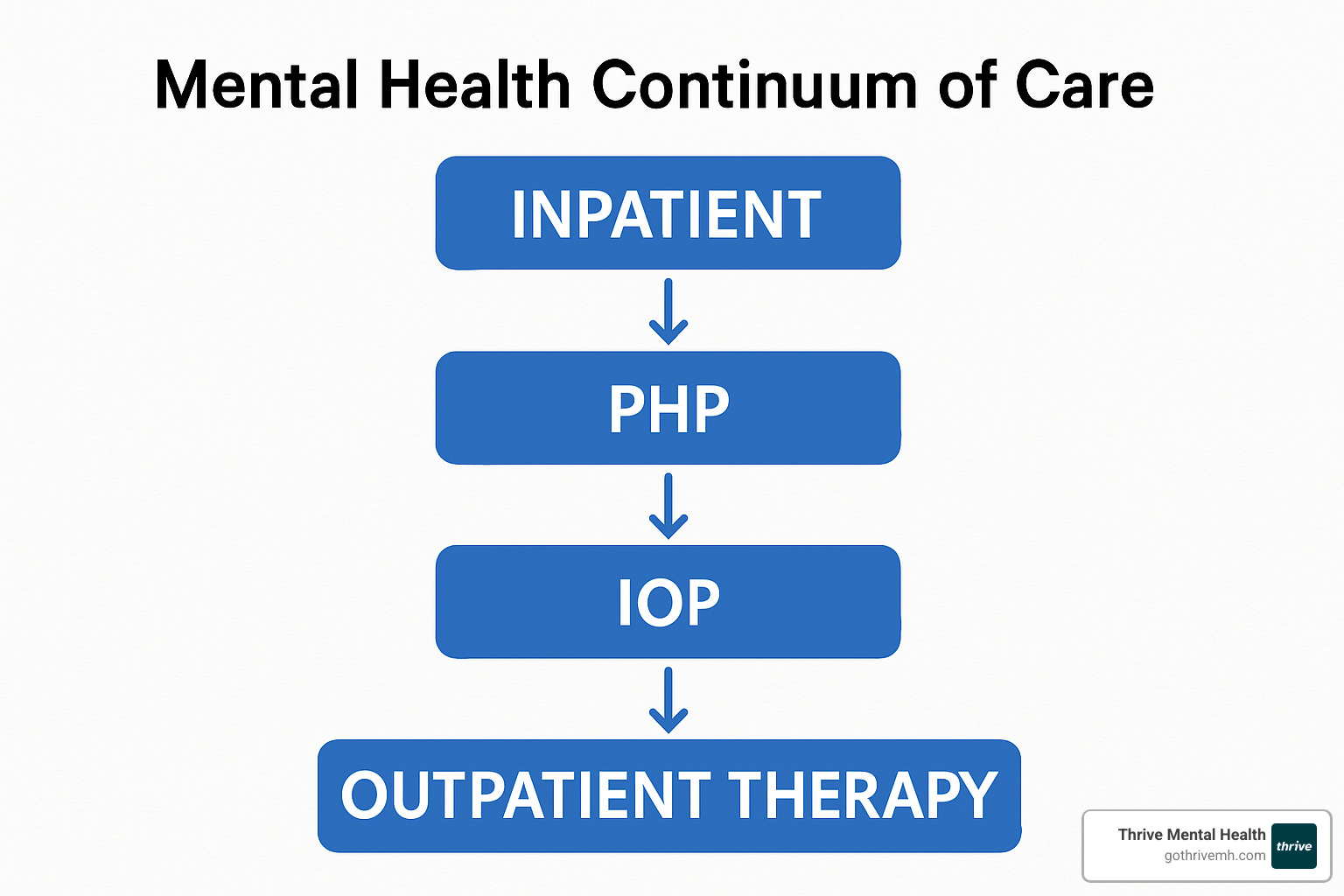PHP or IOP – Which Mental Health Program Fits Your Needs?

Understanding Your Mental Health Treatment Options
What is the difference between PHP and IOP? Here’s a quick comparison:
| Program | PHP (Partial Hospitalization Program) | IOP (Intensive Outpatient Program) |
|---|---|---|
| Time Commitment | 5-7 days/week, 4-6 hours/day | 3-5 days/week, 2-4 hours/day |
| Intensity | Higher intensity, more structure | Moderate intensity, more flexibility |
| Supervision | Higher level of medical oversight | Less medical supervision |
| Best For | Recent inpatient discharge, higher acuity needs | Moderate symptoms, balancing work/school |
| Living Arrangement | Return home each evening | Live at home full-time |
| Cost | Generally more expensive | More affordable option |
When it comes to mental health treatment, understanding all the different options can feel overwhelming. You might be wondering which level of care is right for you or a loved one, especially when facing terms like “PHP” and “IOP” that aren’t part of everyday conversation.
What is the difference between PHP and IOP is one of the most common questions people ask when exploring structured mental health treatment options. In simple terms, both are outpatient programs that allow you to live at home while receiving treatment, but they differ significantly in intensity, time commitment, and level of support.
A Partial Hospitalization Program (PHP) provides intensive, structured treatment during daytime hours without requiring overnight stays. It’s like having the comprehensive care of a hospital setting during the day while returning home each evening. An Intensive Outpatient Program (IOP), on the other hand, offers a step down in intensity, with fewer hours per week and more flexibility to maintain work, school, or family responsibilities.
I’m Nate Raine, CEO of Thrive Mental Health, and I’ve helped hundreds of clients steer what is the difference between PHP and IOP to find the right level of care for their unique needs and circumstances. My experience leading behavioral health programs has shown me that matching treatment intensity to individual needs is crucial for recovery success.

PHP vs IOP: Quick Definitions
Let’s break down these treatment options in simple terms before we explore all the details. Think of these programs as different rungs on a ladder of mental health care – each serving a specific purpose in your recovery journey.
What Is a Partial Hospitalization Program (PHP)?
A Partial Hospitalization Program (PHP) is like getting hospital-level care during the day while sleeping in your own bed at night. It’s designed for folks who need substantial support but don’t require 24-hour hospitalization.
When you participate in a PHP at Thrive Mental Health, you’ll typically spend most of your day (about 4-6 hours) in treatment, 5-7 days per week. Your days are highly structured with a mix of group therapy, individual sessions, and skill-building activities led by our compassionate team of psychiatrists, therapists, and mental health specialists.
What makes PHP unique is the level of medical oversight – you’ll have regular access to psychiatric care and medication management. This intensive approach (classified as Level 2.5 in the ASAM continuum) creates a supportive bridge between hospital stays and less intensive care, giving you space to stabilize and build coping skills before fully jumping back into daily life.

What Is an Intensive Outpatient Program (IOP)?
An Intensive Outpatient Program (IOP) offers a sweet spot between weekly therapy and the more structured PHP environment. It’s like having training wheels as you practice living your regular life while getting substantial support.
In our IOP at Thrive, you’ll typically attend sessions 3-5 days weekly for 2-4 hours each time (usually totaling 9-12 hours per week). What is the difference between PHP and IOP becomes clear when you look at the flexibility – IOPs often offer morning, afternoon, or evening sessions so you can keep working, studying, or handling family responsibilities.
IOPs focus heavily on relapse prevention, practical coping skills, and helping you integrate back into community life. You’ll benefit from a mix of group therapy (where you’ll connect with others facing similar challenges), individual counseling, and sometimes family sessions. This balanced approach (Level 2.1 in the ASAM system) allows you to immediately practice what you’re learning in real-world settings.
Our IOP programs at Thrive Mental Health are customized to your unique situation, with both virtual and in-person options to fit your lifestyle and location needs. For more detailed information about our approach, check out our Intensive Outpatient Programs page or learn more about our Partial Hospitalization Program (PHP).
What is the Difference Between PHP and IOP?
Now that we’ve established the basic definitions, let’s explore the key differences between PHP and IOP in greater detail.
Treatment Intensity – what is the difference between php and iop
The most significant difference between PHP and IOP comes down to the intensity of treatment you’ll receive. Think of it as the difference between immersing yourself in a language course versus taking evening classes.
With a PHP treatment program, you’re committing to a much more intensive experience. You’ll attend 5-7 days each week, with sessions lasting 4-6 hours daily—that’s 20-30+ hours weekly of focused therapeutic work. Your days will be filled with more group therapy sessions than individual ones, with daily check-ins with your treatment team. The medical and psychiatric services are comprehensive, including structured meal support for those with eating disorders and close monitoring of medication adjustments.
In contrast, an IOP treatment program requires less time but still provides meaningful support. You’ll typically attend 3-5 days weekly with sessions running 2-4 hours (totaling 9-12 hours weekly). The therapy mix is more balanced between group and individual sessions, with weekly rather than daily check-ins. While psychiatric oversight is less frequent, there’s a stronger emphasis on applying what you learn between sessions and developing self-management of your medication.
Research backs up what we see in practice: matching treatment intensity to your personal needs is crucial for recovery success. A 2015 literature review found that IOPs significantly reduce substance use and improve mental health outcomes, making them a viable alternative to inpatient treatment for many people. You can learn more about this research in the Journal of Substance Abuse Treatment.
Supervision & Medical Support – what is the difference between php and iop
Another key distinction lies in the level of supervision and medical support you’ll receive in each program.
In a PHP setting, you’ll have daily access to psychiatrists or psychiatric nurse practitioners. This means medication adjustments can happen quickly with close monitoring of how you’re responding. The staff-to-client ratio is higher, allowing for more immediate intervention if you’re struggling. If you have co-occurring medical conditions, you’ll benefit from comprehensive monitoring in a structured environment designed to ensure your safety.
With IOP support, psychiatric appointments typically happen weekly or bi-weekly. Medication management is less intensive, and the staff-to-client ratio is lower. Crisis support is available but not as immediate. Rather than direct medical services, the focus shifts to medical coordination, with greater emphasis on your ability to self-monitor between sessions.
Scheduling & Lifestyle Impact
The way each program fits into your daily life creates perhaps the most practical difference between PHP and IOP.
A PHP schedule represents a full daytime commitment, typically running from 9am to 3pm or similar hours. This makes it difficult to maintain full-time work or school obligations. While your evenings remain free for family time and self-care, you’ll have limited time for other appointments or responsibilities during the day.
An IOP schedule offers much more flexibility as a part-time commitment. Many of our clients at Thrive Mental Health maintain work, school, or family responsibilities while in treatment. We offer morning, afternoon, or evening sessions to accommodate your life.

At Thrive Mental Health, we understand that scheduling flexibility can make or break your ability to commit to treatment. That’s why we offer virtual IOP options that eliminate commute time and make treatment more accessible, especially if you’re a working professional or have family obligations that make traditional treatment schedules challenging.
Who Benefits From Each Program & How to Choose
Deciding between PHP and IOP isn’t just about clinical definitions—it’s about finding the right fit for your unique situation. I’ve seen how matching someone to the appropriate level of care can make all the difference in their recovery journey.
Ideal Candidates for PHP
PHP works wonderfully for people who need that extra layer of support while still maintaining some connection to home life. You might be an ideal candidate for PHP if you’ve recently stepped down from a hospital stay and need a structured transition back to everyday life.
Moderate to severe symptoms that significantly impact your daily functioning are another sign that PHP might be right for you. If you’re finding it hard to complete basic tasks or maintain your usual routine, the daily structure of PHP can provide the framework needed to rebuild those skills.
Many people enter PHP when they’re undergoing medication changes that need close monitoring. The daily contact with medical professionals means any side effects or adjustments can be addressed quickly, rather than waiting for a weekly appointment.
PHP is also particularly helpful for those with limited support systems at home or unstable living environments. The program becomes a reliable constant in your day, providing stability that might be lacking elsewhere in your life.
Ideal Candidates for IOP
IOP strikes that balance between getting substantial therapeutic support while maintaining your regular life commitments. You might be well-suited for IOP if you have mild to moderate symptoms that impact your life but don’t require daily professional monitoring.
Having stable housing and supportive relationships makes IOP more feasible, as you’ll be spending more time in your home environment. This stability provides the foundation needed to practice new skills between sessions.
One of the biggest advantages of IOP is the ability to balance treatment with work, school, or family obligations. Many of our clients at Thrive Mental Health continue working full-time or attending classes while participating in our IOP programs—something that’s much harder to do in a PHP setting.
IOP is often perfect for those stepping down from more intensive care after showing improvement. It provides continued support while allowing for more independence and real-world skill application.

Key Questions to Ask Before Deciding
When I’m helping someone decide what is the difference between PHP and IOP means for their specific situation, I encourage them to reflect on several important questions.
Think about your symptom severity—do your challenges significantly impact your daily functioning? Consider your home support system too. A strong support network might make IOP more feasible, while limited support might suggest PHP would be better.
Your ability to maintain safety between sessions is crucial. Be honest with yourself about whether you can manage symptoms when not in treatment. Also consider your work and family obligations—can they be adjusted temporarily, or do you need a program that works around them?
Practical matters matter too. Transportation to and from treatment several times a week can be a barrier for some people. And of course, insurance coverage often influences these decisions—at Thrive Mental Health, our team can help you understand what your benefits will cover.
Costs, Insurance, and Expected Outcomes
Let’s talk money and results—two things that matter tremendously when you’re considering mental health treatment options.
Typical Insurance Coverage Differences
When it comes to insurance coverage, PHP and IOP programs have some notable differences that might affect your choice:
For PHP coverage, you’ll typically find:
– Most insurance plans require pre-authorization before you start treatment
– Your copays might be higher simply because PHP is more intensive care
– Many plans limit coverage to 15-30 days
– Insurance companies often want documentation proving PHP is medically necessary for you
IOP coverage tends to be a bit more accessible:
– While pre-authorization is still common, it’s often easier to get approved
– Copays are generally lower than PHP programs
– Insurance typically covers longer treatment periods—often 8-12 weeks of care
– You’re more likely to find in-network IOP options in your area
The good news? The Mental Health Parity and Addiction Equity Act has your back. This law requires insurance companies to provide mental health benefits at the same level as medical benefits, which has made both PHP and IOP more accessible in recent years.

Measuring Success & Long-Term Results
“But does it actually work?” This is the million-dollar question, and thankfully, research gives us some encouraging answers.
What does success look like in PHP programs?
Research shows PHP can be just as effective as inpatient care for many people—without requiring you to sleep at the hospital. Studies consistently show improved social functioning and reduced symptoms after completing PHP. Most people stay in PHP for about 2-6 weeks, and success rates climb highest when PHP is followed by step-down care like IOP.
What about IOP outcomes?
The research here is equally promising. A comprehensive 2015 literature review found that IOPs significantly reduce substance use and improve mental health symptoms. About 40-60% of participants maintain their recovery at one-year follow-up—a remarkable statistic in the mental health field. Most people participate in IOP for 8-12 weeks, though research shows that longer engagement (12+ weeks) tends to produce better outcomes.

At Thrive Mental Health, we’re data people—we carefully track outcomes to continuously improve our programs. Our clients consistently report significant symptom reduction, better daily functioning, and improved quality of life after completing our PHP and IOP programs.
Continuum of Care: Transitions & Aftercare
The mental health journey rarely follows a straight line. Instead, it often resembles a winding path where you might need different levels of support at different times. This is why understanding the continuum of care is so important when considering what is the difference between PHP and IOP.
Moving From PHP to IOP Smoothly
Transitioning from the structure of a Partial Hospitalization Program to the more flexible Intensive Outpatient Program is a significant milestone in recovery. When done thoughtfully, this step-down approach can feel like a natural progression rather than a jarring change.
At Thrive Mental Health, we’ve found that the most successful transitions happen gradually. Rather than abruptly ending PHP and starting IOP the following week, we often recommend overlapping the programs. You might attend PHP four days and IOP one day, then three days PHP and two days IOP, slowly shifting the balance until you’re fully in the IOP program.
Family involvement is another crucial element of smooth transitions. When loved ones understand what is the difference between PHP and IOP and the changing expectations, they can provide more effective support at home. We encourage family sessions during transition periods to ensure everyone is aligned with the new treatment schedule and goals.

Life After IOP
Completing an IOP program is a tremendous achievement, but it’s not the finish line—it’s more like reaching a new chapter in your ongoing wellness story. The skills and insights gained during treatment become the foundation for continued growth.
Effective aftercare typically includes weekly therapy sessions with an outpatient provider who understands your history and treatment goals. This ongoing connection provides continuity and a space to continue processing life’s challenges using the skills you’ve developed.
For many clients, peer support groups become an invaluable part of life after IOP. Whether in-person or virtual, these communities offer understanding and encouragement from people who truly “get it.” At Thrive, our alumni program creates opportunities for graduates to stay connected and even mentor newer clients.
Perhaps most importantly, we work with each client to develop a personalized crisis response plan. This document outlines specific steps to take if symptoms intensify, including who to call, when to reach out, and which coping strategies to try first. Having this roadmap provides peace of mind as you steer life beyond the structured treatment environment.
Frequently Asked Questions about PHP vs IOP
How long does each program usually last?
PHP Duration:
Most people participate in PHP for about 3-4 weeks, though the range is typically 2-6 weeks. Your journey might be shorter or longer depending on your progress, how you’re responding to treatment, and what your insurance covers.
IOP Duration:
IOP programs generally run a bit longer—typically 8-12 weeks. Some clients make rapid progress and complete the program in 6 weeks, while others benefit from extending to 16 weeks or beyond. What matters most is sustainable progress, not checking boxes on a calendar.
Can I work or study while enrolled?
Working During PHP:
Balancing full-time work or school with PHP is challenging. With sessions running 4-6 hours daily for 5-7 days each week, most of your daytime hours are spoken for. Many clients find creative solutions like working part-time (especially evening shifts), taking temporary medical leave through FMLA, reducing their course load, or handling limited remote work in the evenings.
Working During IOP:
IOP is specifically designed with your real-life responsibilities in mind. Many of our clients successfully maintain full-time jobs or attend school while in treatment. The flexibility to choose morning, afternoon, or evening sessions makes all the difference. Our virtual IOP options are particularly popular with working professionals since they eliminate commute time.
What therapies will I receive?
Common Therapies in Both Programs:
You’ll experience a blend of proven therapeutic approaches in both programs, including Cognitive Behavioral Therapy (CBT) to reshape unhelpful thought patterns, Dialectical Behavior Therapy (DBT) for emotional regulation and distress tolerance, and mindfulness practices that bring you back to the present moment. Group therapy forms the backbone of both programs, supplemented by individual sessions, family involvement, and comprehensive education about your specific mental health conditions.
According to the American Psychological Association, these evidence-based therapies have shown consistent effectiveness across various mental health conditions and treatment settings.
At Thrive Mental Health, we don’t believe in cookie-cutter treatment. Your therapy plan is customized to address your specific challenges, drawing from our extensive toolkit of evidence-based approaches that have helped countless clients before you.
Conclusion & Next Steps
Finding your way through mental health treatment options can feel overwhelming, but understanding the differences between PHP and IOP is a crucial step toward healing. What is the difference between PHP and IOP isn’t just about schedules and hours—it’s about finding the right balance of support that meets you exactly where you are in your recovery journey.
As we’ve explored throughout this guide, PHP offers that higher level of care with daily sessions and more medical oversight. It creates a safety net for those transitioning from hospital stays or needing more intensive support. IOP, on the other hand, gives you that breathing room to practice new skills in your daily life while still providing the structure and guidance needed to make real progress.
Both programs have proven track records of success when matched correctly to individual needs. Many people find that moving through these levels of care—perhaps starting with PHP and gradually stepping down to IOP as they build strength and stability—creates a smooth path toward lasting wellness.
Our team of compassionate clinicians offers both PHP and IOP programs, available virtually and in-person across Florida. We’ve designed our programs with flexibility in mind because we understand that healing shouldn’t have to mean putting your entire life on hold. Whether you’re in Tampa Bay, St. Petersburg, Central Florida, or connecting virtually from elsewhere, we’re here to meet you where you are—both geographically and in your mental health journey.
Taking that first step is often the hardest part. If you’re feeling uncertain about which level of care might be right for you or a loved one, we’re here to help make that decision clearer. Our team can walk you through a confidential assessment that considers your unique needs, challenges, and goals.
Ready to explore how our PHP and IOP programs might fit into your recovery journey? Reach out to our team today. Let’s find the path forward together.
One thought on “PHP or IOP – Which Mental Health Program Fits Your Needs?”
Comments are closed.